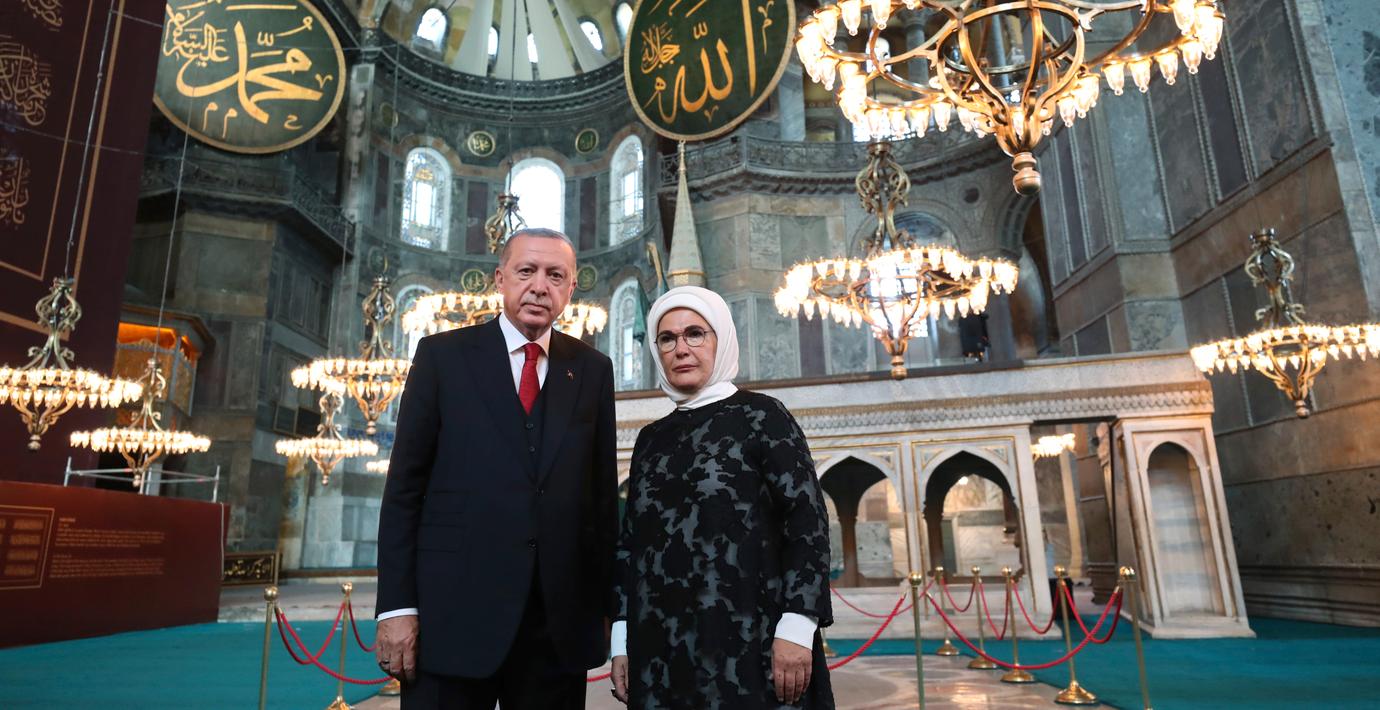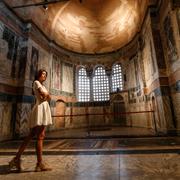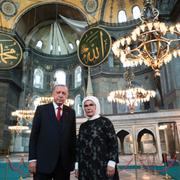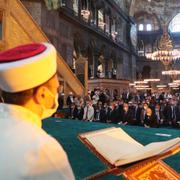
Erdogan med vid den första fredagsbönen i Hagia Sofia
Turkiets president Recep Tayyip Erdogan närvarade vid den första fredagsbönen i Hagia Sofia på 86 år, rapporterar internationella medier.
Flera hundra särskilt inbjudna personer deltog i ceremonin inne i den nyligen omvandlade moskén medan stora folkmassor samlats i anslutning till Hagia Sofia.
– Vi avslutar vår 86 år långa längtan i dag, säger Sait Colak, en av dem som var på plats utanför.
Helgedomen i Istanbul som byggdes på 600-talet har stor betydelse för både kristna och muslimer. Den omvandlades 1934 till museum, men tidigare i juli fattade högsta domstolen i Turkiet det kontroversiella beslutet att tillåta den historiska byggnaden att återigen bli moské, något som Erdogan kämpat för de senaste åren.
bakgrund
Hagia Sofia
Wikipedia (en)
Hagia Sophia (; from the Koinē Greek: Ἁγία Σοφία, romanized: Hagía Sophía; Latin: Sancta Sophia or Sancta Sapientia, 'Holy Wisdom'), officially the Ayasofya Grand Mosque (Turkish: Ayasofya-i Kebir Camii Şerifi) and formerly the Church of Hagia Sophia, is a Late Antique place of worship in Istanbul. Built in 537 as the patriarchal cathedral of the imperial capital of Constantinople, it remained the largest church of the Eastern Roman (Byzantine) Empire, except from 1204 to 1261 when it was converted to a Roman Catholic cathedral. In 1453, it was converted into an Ottoman mosque upon the fall of the city. In 1935 it became a secular museum, and in 2020 it re-opened as a mosque. Completed during the reign of the eastern Roman emperor Justinian I, it was then the world's largest interior space and among the first to employ a fully pendentive dome. It is considered the epitome of Byzantine architecture and is said to have "changed the history of architecture".Built as the Christian cathedral of Constantinople between 532 and 537 on the orders of Justinian I, the basilica was designed by the Greek geometers Isidore of Miletus and Anthemius of Tralles. The present Justinianic building was the third church of the same name to occupy the site, the prior one having been destroyed in the Nika riots. Being the episcopal see of the ecumenical patriarch of Constantinople, it remained the world's largest cathedral for nearly a thousand years, until Seville Cathedral was completed in 1520.
The church was dedicated to the Wisdom of God, the Logos, the second person of the Trinity, its patronal feast taking place on 25 December (Christmas), the commemoration of the birth of the incarnation of the Logos in Christ. Sophia is the Latin transliteration of the Greek word for wisdom and although sometimes referred to as Sancta Sophia, 'Saint Sophia', it is not connected with Sophia the Martyr. The centre of the Eastern Orthodox Church for nearly one thousand years, the building witnessed the excommunication of Patriarch Michael I Cerularius officially delivered by Humbert of Silva Candida, the papal envoy of Pope Leo IX in 1054, an act that is commonly considered the start of the East–West Schism. In 1204, it was converted by the Fourth Crusaders to a Roman Catholic cathedral under the Latin Empire, before being restored to the Eastern Orthodox Church upon the return of the Byzantine Empire in 1261. The doge of Venice who led the Fourth Crusade and the 1204 Sack of Constantinople, Enrico Dandolo, was buried in the church.
After the Fall of Constantinople to the Ottoman Empire in 1453, it was converted to a mosque by Mehmed the Conqueror. The patriarchate moved to the Church of the Holy Apostles, which became the city's cathedral. Although some parts of the city had fallen into disrepair, the cathedral had been maintained with funds set aside for this purpose, and the Christian cathedral made a strong impression on the new Ottoman rulers who conceived its conversion. The bells, altar, iconostasis, ambo and baptistery were removed and relics destroyed. The mosaics depicting Jesus, his mother Mary, Christian saints, and angels were eventually destroyed or plastered over. Islamic architectural features were added, such as a minbar (pulpit), four minarets, and a mihrab – a niche indicating the direction of prayer (qibla). From its initial conversion until the construction in 1616 of the nearby Sultan Ahmed Mosque, aka the Blue Mosque, it was the principal mosque of Istanbul. The Byzantine architecture of the Hagia Sophia served as inspiration for many other religious buildings from the Hagia Sophia, Thessaloniki and Panagia Ekatontapiliani to the Blue Mosque, the Şehzade Mosque, the Süleymaniye Mosque, the Rüstem Pasha Mosque and the Kılıç Ali Pasha Complex.
The complex remained a mosque until 1931, when it was closed to the public for four years. It was re-opened in 1935 as a museum by the secular Republic of Turkey. According to data released by the Ministry of Culture and Tourism, Hagia Sophia was Turkey's most visited tourist attraction in 2015 and 2019.In early July 2020, the Council of State annulled the Cabinet's 1934 decision to establish the museum, revoking the monument's status, and a subsequent decree by Turkish president Recep Tayyip Erdoğan ordered the reclassification of Hagia Sophia as a mosque. The 1934 decree was ruled to be unlawful under both Ottoman and Turkish law as Hagia Sophia's waqf, endowed by Sultan Mehmed, had designated the site a mosque; proponents of the decision argued the Hagia Sophia was the personal property of the sultan. This redesignation is controversial, invoking condemnation from the Turkish opposition, UNESCO, the World Council of Churches, and many international leaders.
Omni är politiskt obundna och oberoende. Vi strävar efter att ge fler perspektiv på nyheterna. Har du frågor eller synpunkter kring vår rapportering? Kontakta redaktionen


